This article needs additional citations for verification .(July 2011) (Learn how and when to remove this template message) |
Santa Isabel de Utinahica (ca. 1610 – ca. 1640) was a 17th-century Spanish mission believed by the Fernbank Museum of Natural History to be located in modern-day Telfair County, Georgia, near Jacksonville. It served the Utinahica tribe, who lived in the area. The small mission was a part of a series of missions set up in what was then the northern reaches of the Spanish colony of Spanish Florida, similar to the Spanish Missions in California or Mexico.

Spain, officially the Kingdom of Spain, is a country mostly located on the Iberian Peninsula in Europe. Its territory also includes two archipelagoes: the Canary Islands off the coast of Africa, and the Balearic Islands in the Mediterranean Sea. The African enclaves of Ceuta and Melilla make Spain the only European country to have a physical border with an African country (Morocco). Several small islands in the Alboran Sea are also part of Spanish territory. The country's mainland is bordered to the south and east by the Mediterranean Sea except for a small land boundary with Gibraltar; to the north and northeast by France, Andorra, and the Bay of Biscay; and to the west and northwest by Portugal and the Atlantic Ocean.

Fernbank Museum of Natural History, in Atlanta, is a museum that presents exhibitions and programming about natural history. Fernbank Museum has a number of permanent exhibitions and regularly hosts temporary exhibitions in its expansive facility, designed by Graham Gund Architects. Giants of the Mesozoic, on display in the atrium of Fernbank Museum, features a 123-foot (37 m) long Argentinosaurus, the largest dinosaur ever classified; as well as a Giganotosaurus. The permanent exhibition, A Walk Through Time in Georgia, tells the twofold story of Georgia's natural history and the development of the planet. Fernbank Museum has won several national and international awards for one of its newest permanent exhibitions, Fernbank NatureQuest, an immersive, interactive exhibition for children that was designed and produced by Thinkwell Group. The awards NatureQuest has won include the 2012 Thea Award for Outstanding Achievement for a Museum Exhibit and the 2011 Bronze Award for Best Museum Environment from Event Design. The nearby Fernbank Science Center is a separate organization operated by the DeKalb County Board of Education and is not affiliated with Fernbank Museum of Natural History.

Telfair County is a county located in the central portion of the U.S. state of Georgia. As of the 2010 census, the population was 16,500. The largest city and county seat is McRae-Helena.
Operating for approximately two decades in the early 17th century, the mission was a religious outpost consisting of one Catholic friar sent out to convert and monitor the native people at the edges of the colony. The name Utinahica was taken from the local Native American chiefdom, themselves a part of the Timucua people and possibly ancestors of the current Creek people.

A friar is a brother member of one of the mendicant orders founded since the twelfth or thirteenth century; the term distinguishes the mendicants' itinerant apostolic character, exercised broadly under the jurisdiction of a superior general, from the older monastic orders' allegiance to a single monastery formalized by their vow of stability. The most significant orders of friars are the Dominicans, Franciscans, Augustinians and Carmelites.

Native Americans, also known as American Indians, Indigenous Americans and other terms, are the indigenous peoples of the United States, except Hawaii. There are over 500 federally recognized tribes within the US, about half of which are associated with Indian reservations. The term "American Indian" excludes Native Hawaiians and some Alaska Natives, while Native Americans are American Indians, plus Alaska Natives of all ethnicities. Native Hawaiians are not counted as Native Americans by the US Census, instead being included in the Census grouping of "Native Hawaiian and other Pacific Islander".
A chiefdom is a form of hierarchical political organization in non-industrial societies usually based on kinship, and in which formal leadership is monopolized by the legitimate senior members of select families or 'houses'. These elites form a political-ideological aristocracy relative to the general group.
The mission's exact location is not presently known with certainty. In April 2006 the Fernbank Museum of Natural History and Georgia Department of Natural Resources began three summer seasons of archeological excavation where the Ocmulgee and Oconee rivers converge to form the Altamaha River. No evidence of the mission was found, and only Muskogean (proto-Creek) architecture and artifacts were uncovered, plus some trade items of probable Spanish origin. In the 17th century the Spanish referred to the Altamaha River as the Rio de Santa Isabel, after the short-lived mission.

The Georgia Department of Natural Resources (DNR) is an administrative agency of the U.S. state of Georgia. The agency has statewide responsibilities for managing and conserving Georgia’s natural, cultural, and historical resources, and has six divisions:

The Ocmulgee River (ok-MUHL-gee) is a western tributary of the Altamaha River, approximately 255 mi (410 km) long, in the U.S. state of Georgia. It is the westernmost major tributary of the Altamaha.

The Oconee River is a 220-mile-long (350 km) river which has its origin in Hall County, Georgia, and terminates where it joins the Ocmulgee River to form the Altamaha River near Lumber City at the borders of Montgomery County, Wheeler County, and Jeff Davis County. South of Athens, two forks, known as the North Oconee River and Middle Oconee River, converge to form the Oconee River. Milledgeville, the former capital city of Georgia, lies on the Oconee River.





